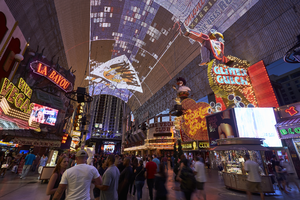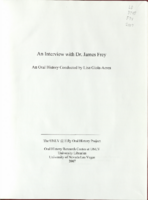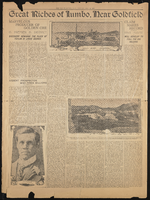Search the Special Collections and Archives Portal
Search Results

Photographs of La Bayou Casino, Las Vegas (Nev.), June 24, 2016
Date
Archival Collection
Description
Site address: 15 Fremont St
Sign owner: Derek Stevens
Sign details: Opened 1920 as Northern Club By Mayme Stocker. 1943-1960 operated as a few different businesses. 1970 opened as The Coin Castle, 1999 was renovated and opened as La Bayou, 2016 bought by Derek Stevens and torn down.
Sign condition: No longer there
Sign form: Architectural sign
Sign-specific description: Three neon signs site on top of a shack made of wood and sheet metal that is meant to represent something that might be seen in Louisiana. Two windows with green shutters are "open" with T.V. screens inside. Two neon signs sit at the top of the shack that spell out La Bayou in red neon and the cabinet is trimmed with purple neon. At the front of the property, above the entry, is a red neon sign that says "26 New Orleans Daiquiris."
Sign - type of display: Neon and incandescent
Sign - media: Steel, fiberglass
Sign environment: Part of the Fremont Street Experience, next to Golden Gate Casino
Sign - date of installation: c. 1999
Sign - thematic influences: The property has a theme element, which was popular of casinos of Las Vegas in the 1990s.
Sign - artistic significance: Property was decorated with a Louisiana inspired bayou, swamp motif.
Survey - research locations: Newspapers
Survey - research notes: https://www.reviewjournal.com/business/casinos-gaming/mermaids-la-bayou-and-glitter-gulch-come-to-a-close-on-fremont-photos/ https://lasvegassun.com/news/2016/jun/25/patrons-say-farewell-to-mermaids-and-la-bayou-in-d/ http://classiclasvegas.squarespace.com/downtown-history/?currentPage=3
Survey - other remarks: Property was razed 2016
Surveyor: Wyatt Currie-Diamond
Survey - date completed: 2017-09-08
Sign keywords: Architectural; Neon; Incandescent; Steel; Fiberglass
Mixed Content
C. D. Baker Photograph Collection
Identifier
Abstract
The C. D. Baker Photograph Collection depicts former Las Vegas, Nevada mayor Charles Duncan "C. D." Baker from 1916 to 1966. The photographs primarily depict Baker at political events, including campaign stops, fundraising events, meetings with officials and politicians, and at important locations in Las Vegas and Nevada. Baker was photographed with politicians such as U.S. Senator Chic Hecht, President Harry S. Truman, Governor Vail Pittman, and Lt. Governor Cliff Jones.
Archival Collection
Spencer and Georgia Hanna Butterfield Photograph Collection
Identifier
Abstract
The Spencer and Georgia Hanna Butterfield Photograph Collection (approximately 1900-1978) consists of black-and-white photographic prints and negatives of the Hanna and Butterfield families. It also contains images of early and prominent residents of Las Vegas, Nevada such as James Cashman Sr., Las Vegas Chamber of Congress members, Union Pacific Railroad president George Ashby, and many other notable persons from early Las Vegas. The collection also includes photographs taken in Elko County, Nevada, the Hoover Dam, and other Las Vegas area images.
Archival Collection
John R. Moser Real Estate Appraisal Records
Identifier
Abstract
Collection contains nineteen real estate appraisal reports created by John R. Moser from Las Vegas and rural Southern Nevada (Lincoln and Nye counties) from approximately 1957 to 1972. The reports contain information on the market values of the properties and contextual information explaining the appraisals. This collection also contains photographs and photographic negatives depicting properties, and photographic slides of desert flora and landscapes around Nevada and Idaho such as Groom Mountain Range, White Bird Canyon, Salmon River Valley, Clover Valley, and Ruby Mountains.
Archival Collection
Spencer and Georgia Butterfield Papers
Identifier
Abstract
The Spencer and Georgia Butterfield Papers (1890s-1978) consist primarily of photographs and scrapbooks pertaining to Spencer and Georgia Butterfield, a prominent Las Vegas, Nevada couple involved in local business and civic activities. The collection also includes newspaper clippings of their social activities, correspondence, and assorted personal memorabilia.
Archival Collection
Frontier Girl Scouts Records
Identifier
Abstract
The collection consists of records of the Frontier Girl Scouts Council (FGSC) dating from 1944 until 1999. The majority of the collection dates from 1990 to 1999. It contains annual reports and publications of the FGSC, committee minutes and agenda, troop financial records, membership data, and leader training records. It also includes correspondence and publications of the Girl Scouts of the USA (GSUSA).
Archival Collection
Bill Schafer Papers
Identifier
Abstract
The Bill Schafer Papers (1980-2018) contain personal and professional papers of Las Vegas, Nevada journalist and publisher, Bill Schafer, and photographs from various LGBTQIA+ related events in Las Vegas. The materials include files related to Schafer's work managing the
Archival Collection
Jesus Jara (Clark County School District, Superintendent) oral history interview conducted by Magdalena Martinez and Elia Del Carmen Solano-Patricio: transcript
Date
Archival Collection
Description
From the Lincy Institute "Perspectives from the COVID-19 Pandemic" Oral History Project (MS-01178) -- Education sector interviews file.
Text

Transcript of interview with Dr. James Frey by Lisa Gioia-Acres, February 14, 2007
Date
Archival Collection
Description
Text

